The UFO Events at Minot AFB (one of the best cases ever)
A Narrative of UFO Events at Minot AFB
PART 3
Thomas Tulien
Narrative of UFO Events at Minot AFB
on 24 October 1968
Thomas Tulien
Sign Oral History Project
February 2011
Abstract
Sign Oral History Project
February 2011
Abstract
In the early morning hours of 24 October 1968, United States Air Force maintenance and security personnel at the Minuteman ICBM missile complex surrounding Minot Air Force Base, North Dakota, observed one—and at times, two—UFOs. The Base Operations Dispatcher established radio communications with the ground personnel reporting in the field; Minot AFB, Radar Approach Control (RAPCON); and the crew of a returning B-52H Stratofortress aircraft.
RAPCON alerted the B-52 pilots to the location of the UFO high in the northwest, which was observed on the B-52 radarscope maintaining a three-mile distance throughout a standard 180° turnaround. As the B-52 initiated the descent back to Minot AFB, the UFO closed distance to one-mile at a high-rate of speed, while pacing the aircraft for up to 20 miles before disappearing off the radarscope. During the close radar encounter, the B-52 UHF radios would not transmit. Radarscope film was recorded.
Shortly afterward, RAPCON provided vectors for the B-52 to fly over a stationary UFO. During the downwind leg of the traffic pattern, the pilots observed an illuminated, stationary UFO ahead of the aircraft on or near the ground, before turning onto the base leg over the large UFO and observing it at close range. After the B-52 landed, both outer and inner-zone intrusion alarms activated at the missile Launch Facility designated Oscar-7. Altogether, reported observations continued over a period of about three hours.
In the weeks following, staff at USAF Project Blue Book completed a final case report as required by Air Force Regulation 80-17.[1]
--------------
Narrative of UFO Events at Minot AFB
on 24 October 1968
Thomas Tulien
1. Ground-visual UFO Observations (2:15-3:44)[2]
The initial observation of an unidentified flying object was reported by
a Camper Team, comprising Airman First Class (A1C) R. McDowell, and A1C
W. Johnson. A camper team is a security detachment in a camper truck,
which can be posted on site to provide temporary security during
equipment failure, or whenever a nuclear warhead is exposed during
maintenance procedures. In this instance, McDowell and Johnson were
stationed at the missile Launch Facility (LF) designated Oscar-6,
providing aboveground security for a Target Alignment Team working on
the Minuteman ICBM in the underground silo.[3]
At 2:15 a.m., the team radioed Oscar-Flight Security Controller (FSC),
Staff Sergeant (SSgt.) William Smith Jr., at the O-1 Launch Control
Facility (LCF), to report the presence of a strange light near their
post. In an August 2001 interview, Smith recalled the Camper Team
observed “a large glowing object go down by some trees not far away,”
and that members of the Target Alignment Team also observed the strange
light.[4]
At 2:30, Smith also observed the glowing object himself in the vicinity of O-6. In his Air Force Form 117 (AF-117), Sighting of Unidentified Phenomena Questionnaire, he reported:
I was notified it had been seen in an adjacent area. I alerted my [sentries]. The object was first seen in the southern part of my area by a posted sentry. I directed my gaze south of my position and saw the object about fifteen minutes after my sentry sighted it.[5]
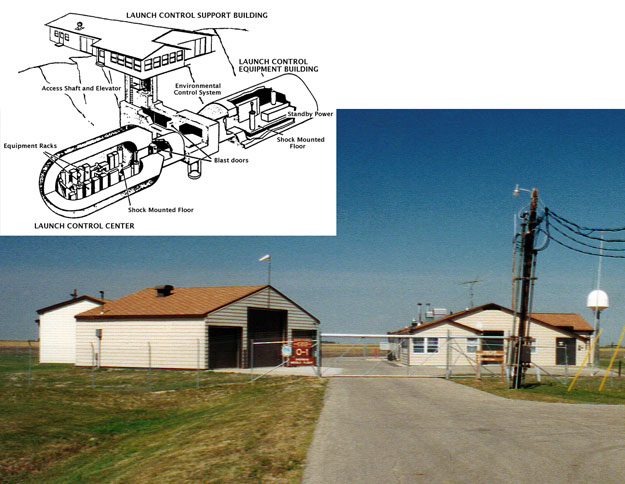
Oscar-1 Launch Control Facility located 28 miles
north of Minot AFB, looking north; and (inset) the underground Launch
Control Center. Two Missile Combat Crew Commanders (capsule crew) are
stationed in the LCC, and constantly monitor missile launch status and
security for 10 missiles encircling the LCF. Aboveground, the LCF is
manned by a minimum of six security personnel responsible for the
security requirements of the capsule crew, who remain locked in the
underground capsule for 24-hour tours of duty. The security personnel
were divided into two teams of three people each, consisting of a Flight
Security Controller (FSC) and two Security Alert Team (SAT) members.
Each team operated in 12-hour shifts over a three-day period. Bruce
Ecker’s spherical panoramic photographs of a decommissioned Minuteman
LCF, LCC, and LF at Ellsworth, AFB, SD, are available from: http://nonplused.org/panos/minuteman/index.html.
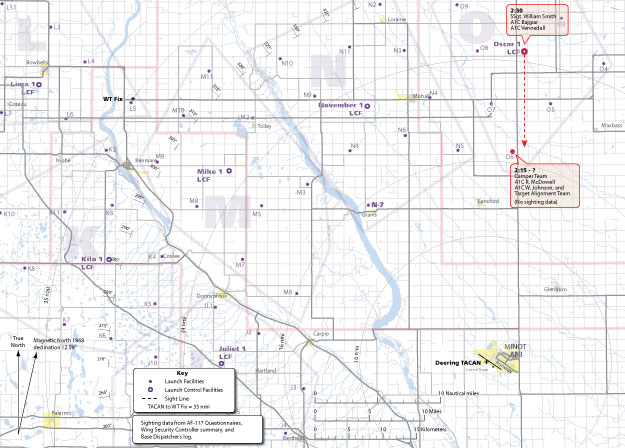
Locations of the initial observations of “a large
glowing object” by the camper team at O-6, and security team at the
Oscar-1 Launch Control Facility, 9 miles to the north. Project Blue Book
investigators did not interview the camper and targeting team personnel
during the subsequent investigation. A satellite view of Oscar-Flight
(zoom-in to view Oscar-1) is available from: Wikimapia.
Smith reported his observation to Tech Sergeant Bowles at the 91st Strategic Missile Wing, Security Control, at Minot AFB.[6]
Apprehensive about the unknown object so close to the exposed nuclear
warhead, the Captain in charge of the targeting team informed the
Missile Combat Crew Commander in the underground Oscar-Launch Control
Center, to the effect, “we can do this another time, its just not worth
us being out here,” and they closed the missile silo, secured the site,
and returned to base.[7]
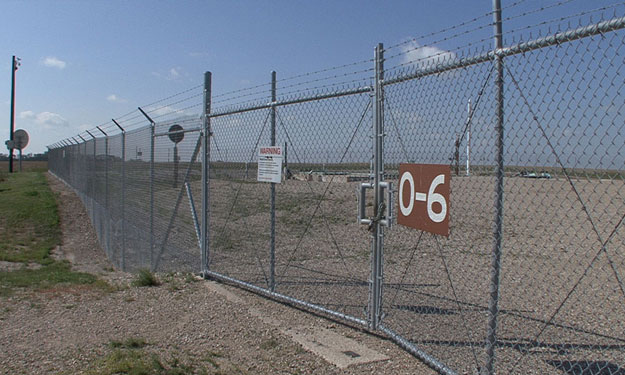
Oscar-6 Launch Facility looking south-southwest. O-6
is located 19 miles north of Minot AFB, to the west of Highway 83.
According to Smith, the camper team was providing aboveground security
for the targeting team working in the missile silo, when they observed a
large glowing object go down behind some trees not far away. Concerned
about an unidentified glowing object near the exposed nuclear weapon
they secured the site and returned to base.
For weeks prior to these events, SSgt. Smith had been observing
inexplicable lights traveling across the sky that would reverse
direction.
SMITH: Most of what we saw were just back and forth patterns. They weren't going very high. . . . We were looking south so they were moving east-west, west-east. They would stop, and they might go up a little bit and go slower, and we're saying “a helicopter might do that, but…” We did call and make the reports as we were supposed to of anything that you cannot explain, but nothing was done. So I talked to the capsule crew again, and said “sir, we're just not happy with what we're seeing.” We had reported this before and they said, “Well, just keep them under observation.”
He recalls that a few days before the events of 24 October there was a
noticable increase in the activity. Asked to explain what he was
observing, he recalled:
SMITH: Seeing a white light, and on clear nights you could see it almost change colors. When I say colors we’re talking a reddish-dark light, almost like a light bulb in the distance that would have a somewhat reddish hue to it. You could even see it change a little bit, almost like an aircraft a long distance away that would have red and green lights, and would revolve—not bright white, dull reddish white. But the lights themselves were doing different things, I mean, we talk about one light but we saw several on occasion, and they were just not doing things we thought aircraft should be doing this time of the morning.[8]
During the same time as the observations near O-6 , A1C Robert O’Connor,
and A1C Lloyd Isley of the 91st Minuteman Maintenance Squadron, were
driving to the Launch Facility designated November-7, to perform routine
missile maintenance. Five miles north of N-7, their attention was drawn
to a luminous object hovering near the horizon in the east. When first
observed at 2:30 a.m., O’Connor reported “It appeared to be between two
farmer yard lights, which were a little smaller, then the object grew
brighter moving S.E.”[9]
In a February 2005 interview, he explained that as they continued down
the gravel road the object rose up and began to pace their movements:
O’CONNOR: We were going down the dirt road and then I glanced out [turns to his left] the truck window and noticed that some farmer had left his yard light on.
INTERVIEWER: There were farms along there?
O’CONNOR: I don’t know because at nighttime it’s so hard to see. You can’t tell if there is a building. It was dark—it gets dark out there when it is cloudy. We started down that road and I noticed that farmer’s yard light, and then—I don’t know what made me glance over at it again—then I saw it raise up and start paralleling our truck going down the road. . . . It was almost on the ground, probably at normal height, which would have been 30-40 feet something like that. It was illuminating the ground. After it picked up and started following us down the road I noticed that the farmer’s light wasn’t there [any] more. [10]
A1C Lloyd Isley also recalled that the unidentified object appeared to follow them down the road to N-7:
ISLEY: It would’ve been up above the horizon line, now whether we could see—it was hard at all times to determine how far away, for whatever reasons, there wasn’t ever a good fix in my mind as to how far this thing was from us. It just seemed to stay with us, and at times, at that time seemed pretty close to us, close enough that it would have been following us and nothing else, you know.
INTERVIEWER: What gave you the impression it was following you?
ISLEY: Well, it wasn’t really behind, it was off to the side of us and it just seemed to be staying at the same speed we were.[11]
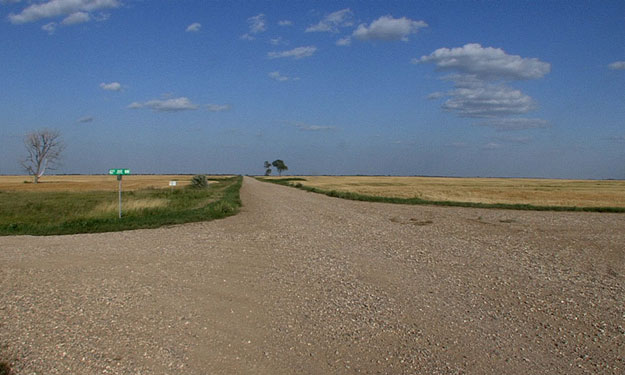
Looking east from the location of O’Connor and
Isley’s initial UFO observation at 2:30 a.m. The O-6 Launch Facility is
due east about 13 miles distant, and November-7 is 5 miles south (to the
right).
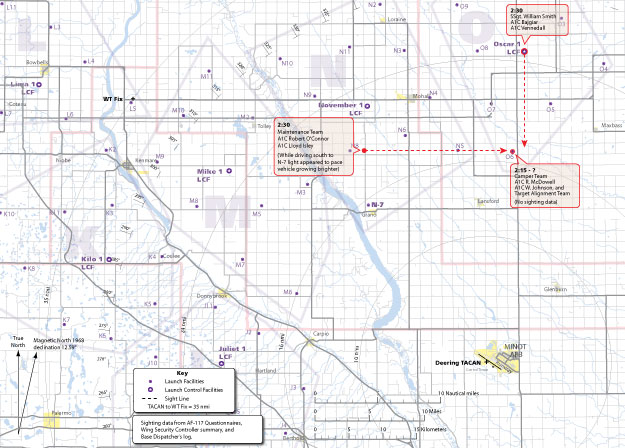
At 2:30 a.m., SSgt. Smith observed the object at the
same time as the maintenance team’s observation on the road 5 miles
north of N-7. It appears they were observing the same object: Isley and
O’Connor’s observation was near the horizon to the east, in a direct
line with O-6 about 13 miles distant; at which time Smith reported the
UFO south of O-1, about 10 miles at 15 degrees elevation, also in the
direction of O-6. A simple triangulation illustrates the UFO in the
immediate vicinity of O-6, as reported to Smith by the Camper Team.[12]
O’Connor also noted in his AF-117 that the “object seemed to be
observing us. When we stopped the object seemed [to] hover or stop when
we turned out our headlights.”[13]
Growing uneasy with a strange light following them, they radioed the
base Transportation Control Center to inquire whether there were any
aircraft operating in the area, but were informed there were no
helicopters or other aircraft out at this hour of the morning.[14]
Since the object did not appear like aircraft routinely observed around
the base, they were uneasy regarding it’s intentions, particularly
because they were unarmed. “I remember Isley getting in the back of the
truck and grabbing an axe, just in case there were some little green men
or something,” O’Connor recalled. “I didn’t know what was going on but I
was totally concerned.”[15]
When Isley and O’Connor arrived at N-7 they parked outside the front
gate and continued observing the object from outside the truck. In his
AF-117, Isley noted it remained circling about 2 miles south of the
Launch Facility, and “came within hearing distance twice.”
We first saw the object to the east of us while we were traveling toward the site. It started moving south. We arrived at the site then started observing the object from outside the truck. It was moving in a large circular area to the south of us. [16]
Isley initially reported the object high above the horizon at 50
degrees: “The object had lights on the front like headlights or landing
lights. It had a green flashing light toward the middle or rear.” Unable
to determine the precise size or shape, he nevertheless compared its
size to a KC-135 Stratotanker “by the lights on the object.” [17]
Likewise, O’Connor reported that:
The object appeared self-luminous like a big ball of white-light that seemed to change to a dim green light then later to a dim amber color. The object seemed to take on the appearance of a stingray fish. . . . I was unable to make out a definite shape because the object put out such a bright light. [18]
Asked to describe the object he recalled:
O’CONNOR: I couldn’t really see a shape other than the light and that it was glowing… You would almost think it was an aircraft but it wasn’t [laughs]. It was hovering above the ground and you could not hear [anything] so I knew it wasn’t a helicopter.
INTERVIEWER: How far away was it?
O’CONNOR: I would say 300-400 yards—it was quite close. I could not compare it to anything other than I knew it was probably as big as a B-52—in that size range.[19]
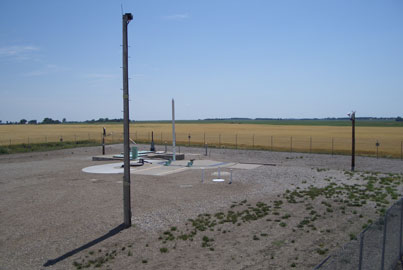
November-7 Launch Facility looking southeast from the front gate, and
(left) illustration of the Minuteman missile in the underground silo.
O’Connor and Isley parked outside the gate and continued to observe the
bright UFO circling to the south. Shortly after 3:00, O’Connor entered
the facility and went down into the Launch Support Building to report to
Flight Security Controller, SSgt. James Bond, at the November Launch
Control Facility, 10 miles to the north. A satellite view of November
Flight (zoom-in to view N-7) is available from Wikimapia.
In response, Transportation Control routed the maintenance teams call to
the Base Operations Dispatcher, who further verified there were no
aircraft in the area. The dispatcher then notified the Minot AFB,
Control Tower operator, and controllers at Radar Approach Control
(RAPCON) establishing a phone patch, and open-line of communications
with the remote observers at N-7. He instructed O’Connor to continue
describing what he was observing, and over the next two hours kept a
written log noting the time and circumstances.[20]
His first entry, at 0800Z (3:00 a.m. CDT), describes the
Object S/E of N-7 moving toward site with brilliant light like the sun. Lights flashing on and off. It’s too brilliant and big for an aircraft now moving south and hovered over N-7, turned green, amber off than on. [21]
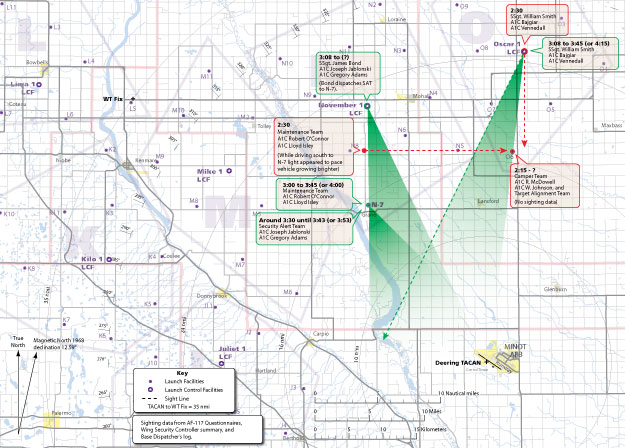
At 2:15, the Camper Team reported a glowing object
near O-6 to SSgt. Smith at O-1. At 2:30, Smith observed the UFO in the
south, at the same time the maintenance team of O‘Connor and Isley
reported a UFO in the east. While driving south to N-7, the UFO appeared
to pace them while growing brighter. By the time they arrived at N-7,
the “big ball of white light” was “moving in a large circular area to
the south.” They reported the observation to SSgt. Bond at November-1.
It appears the UFO traversed roughly 15 miles from O-6 to a position a
few miles southeast of N-7 where it remained for the next hour.
After observing the object for a while, O’Connor unlocked the gate and
hurried down into the Launch Support Building adjacent to the silo, to
phone in their arrival. According to procedure, he authenticated
identification and assigned entry codes with Flight Security Controller,
SSgt. James Bond, at the November-Launch Control Facility. Bond, along
with his Security Alert Team of A1C Joseph Jablonski, and A1C Gregory
Adams, received O’Connor’s report shortly after 3:00 a.m.[22]
In a February 2005 interview, Jablonski recalls O’Connor’s
hysteric-sounding voice over the radio and imagined O’Connor was
describing the object hovering directly over them at N-7. Going outside
for a better view, he and Adams could see the security lights of N-7 to
the south, and a bright light above it, about 35 degrees above the
horizon “alternating all kinds of pretty colors.”[23]
At 3:08, Bond reported the maintenance team’s observation to SSgts. Underhill and Neal at missile Wing Security Control.[24]
The Wing Security controller then alerted adjacent Flight Security
Controllers, and the 91st Strategic Missile Wing, Command Post.[25]
The controller also summarized events in a document later provided to Blue Book investigators. According to his first entry:
At 3:08 hours the initial report was received from a maintenance team enroute from N-8 to N-7. An A1C O’Connor was the maintenance Team Chief and he stated that all members of the team observed the lighted object. They further stated that it was reddish orange in color, a very large object, with flashing green and white lights. After they entered N-7 the object came directly overhead with the sound of jet engines.[26]
The idea that the object “came directly overhead ” seems to result from
O’Connor’s initial excitement, and the original report by Bond that the
object appeared to be hovering above N-7. Neither Isley nor O’Connor
reported the object overhead, though O’Connor reported, “at one time the
object came within about ½ mile of site,” and “the noise I heard was
similar to that of a jet engine only more steady and at a lower pitch.”[27]
Isley noted that when first seen it appeared about 50 degrees above the
horizon, and “came within hearing distance twice. The sound was that of
jet engines.”[28]
In an August 2001 inteview he recalled,
ISLEY: At least once it seemed like it was passing pretty close overhead, and it was at one of these times that I heard some air noise or something that an aircraft might make. I don’t remember hearing any jet engines… maybe what a plane would make going through the air without its engines on—just the air movement across the wings, or whatever.[29]
After receiving O’Connor’s report, SSgt. Bond dispatched Jablonski and
Adams to assist the maintenance team at N-7. Jablonski recalls that
after observing the object, he and Adams returned to the LCF to get
their weapons, and on their way to the pickup passed by all of the N-1
personnel outside observing the bright light in the distance.
Once on the road, the team observed a second, similar object appear out of the east traveling to the south. Jablonski reported:
When first dispatched to N-7 another object exactly the same appeared out of the East and had picked up speed in a path moving towards the other. Never did see the two join or meet as the second one disappeared and no longer could be seen.[30]
Adams concurred: “When enroute to N-7 another object appeared (same as
first one). They seemed to get pretty close at one time and all of a
sudden one disappeared.”[31]
In February 2005, Jablonski further elaborated that after leaving N-1 he
and Adams observed numerous points of light streaking across the sky,
originating from the bright object in the south:
JABLONSKI: I don’t even know if I put this in my report, but I saw lights coming off that, like smaller craft, going like (gestures back and forth path)…. Now these lights that I saw coming off of it while we were going down there were like what you were saying—small, almost like shooting stars but they weren’t because they were actually maneuvering (gestures curving paths), and they were going towards (pointing) that direction of Oscar Flight.
INTERVIEWER: So those objects would have been to the east of you, going up north?
JABLONSKI: Yeah. And he [Adams] saw them too, but he didn’t want to see them (laughs). I said, “Look at what’s going on!”
INTERVIEWER: Did they just disappear?
JABLONSKI: They faded out. But there were so many of them.
INTERVIEWER: How many—more than 10?
JABLONSKI: Oh yeah. This is when we first started out you know, then we focused mainly on that site because we were getting more in a straight line [heading south], and then we weren’t seeing any more of them. [32]
In fact, between 3:20 and 3:25 a.m., at least nine other ground
observers at three LCFs observed two objects in strikingly similar
terms. During the same time that Jablonski and Adams were driving to
N-7, the Wing Security controller noted:
[03:20] SSgt Smith at Oscar-1 saw the object separate in two parts and go in opposite directions and return and pass under each other. At this time [03:24] Juliet Flt and [03:25] Mike Flt Team observed the same things and described it in the same way. [33]
In their AF-117’s, Isley and O’Connor included drawings of a second
object southwest of N-7, while the first object remained in the
southeast.[34]
The time of this observation is not given, although the dispatcher’s log notes at 3:28: “Two are seen now.”[35]
In addition, Bond included a drawing of two objects on a course towards
each other, in which the second object “was in view for only about three
minutes.”[36]

SSgt. Bond’s drawing in his AF-117 (4). If this is
his view from N-1 looking south, then the second object was in the
southwest traveling to the east before disappearing at the point of
contact (Click image for full scan).
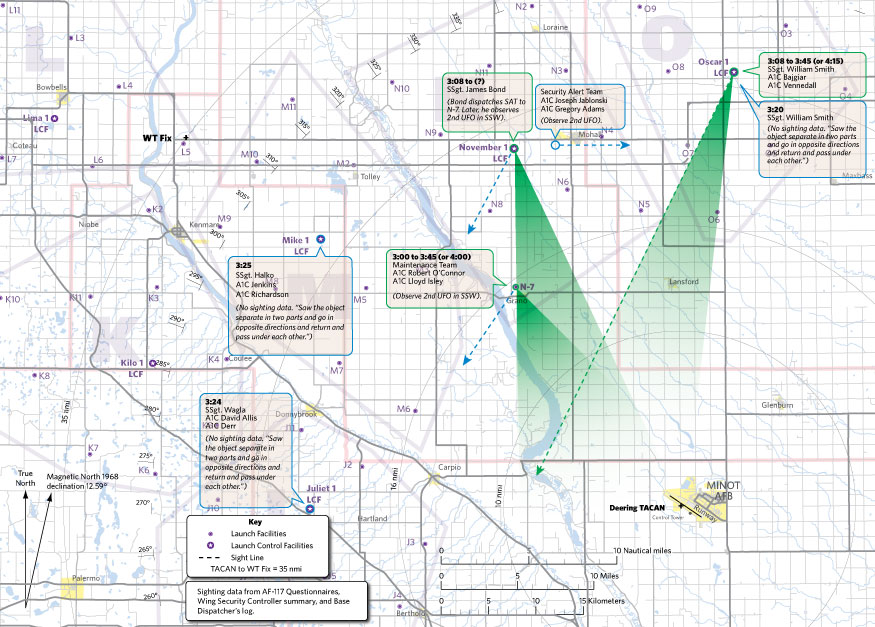
Locations of the ground observations at 3:20-3:25 of
two objects separating in opposite directions and returning to pass
under each other. Additionally, Jablonski and Adams on the road to N-7
observed a second identical object in the east on a path to the first,
which got close and disappeared. O’Connor and Isley at N-7 noted, “at
one time there were two in the area,” indicating a second object in the
southwest. Bond at N-1 noted two objects moving toward each other, and
the second object disappearing at the point of contact, which “was in
view for only about three minutes” (AF-117s, 4). The possibility of two
UFOs was not an issue during the subsequent Blue Book investigation, and
the sighting data is meager. In any case, complete data from the three
LCFs would have certainly resolved the probability that observers were
reporting a celestial object.
Over a distinct period of time, two similar objects were reported moving
in relation to each other by 14 ground observers in diverse locations.
Unfortunately, no specific observational data was obtained during the
subsequent investigation, nor from the security personnel at the
Juliet-1 and Mike-1 Launch Control Facilities, which would allow for
correlations. Later, Minot AFB investigating officer, Lt. Colonel Arthur
Werlich, simply notes in the Basic Reporting Data, “AT ONE POINT DURING
THE GROUND SIGHTINGS, THE FIRST OBJECT WAS OBSERVED JOINED FOR A SHORT
TIME BY A SECOND LIKE OBJECT.”[37]
Other instances in the documentation point to the presence of two UFOs.
For example, at 3:30 [3:40], when the Transcription of Recorded
Conversation commences between RAPCON and the crew of a returning B-52,
the first entry notes, “Controllers received information on UFO 24 miles
NW.”[38]
This location is in Mike-Flight about 7 miles west-northwest of the
observers at N-7, who were reporting a UFO in the southeast.
Jablonski and Adams arrived at the N-7 missile silo around 3:30.[39]
Jablonski recalls that when they pulled up the gates were standing wide open, and O’Connor and Isley were in a frantic state:
JABLONSKI: I was too excited to be scared. When we got there, to see a man with that rank running, I mean they were all telling us ‘Shoot it!’ when we pulled up.
INTERVIEWER: It’s that close?
JABLONSKI: Evidently, it was close in the beginning and then it moved off, but it stayed in the vicinity, you know, it gained altitude or whatever, and you could not hear any engines. [40]
In his AF-117, he noted that the phenomenon was not in sight continuously, indicating that this was
Not due to our movement, but the behavior pattern of the phenomenon. Object appeared as orangish-red lighted, seemed to switch to almost completely white and there was some green. This pattern was not always the same, and at certain times a combination of all could be seen at once. Object first appeared to hover, then move slowly, speed up, always alternating in color. Then lights would vanish, but return some 5 minutes later. [41]
He also recalled:
JABLONSKI: Whatever it was, you could not make out the shape. It was long and slender with lots of lights on it. In the debriefing [they said] that it was the size of a B-52 with a tanker—it had come up on base radar as that big. But the thing of it was the lights, which were alternating—they were bright white to like an amber-red and to a green, back—
INTERVIEWER: What would you compare it to—a nut or a basketball?
JABLONSKI: Oh, it was bigger than that, I mean, it was like the size of the B-52. You could not make—as far as shape you know, ‘saucer-like,’ whatever; it was oblong, slender with lots of lights on it.[42]
Jablonski took over responsibility for radio communications, reported
back to Bond and the capsule crew at N-1, and continued relaying
movements and descriptions of the object to the dispatcher and the
RAPCON controller, who, by this time, was in contact with a returning
B-52.[43]
He explained the difficulty of providing RAPCON with the precise coordinates of the UFO because:
JABLONSKI: The lights were not always on. When it made a move it was without the lights. That’s what was so tough with the B-52, because they wanted coordinates and everything. But when the lights were off you could not see it, as dark as it was.
INTERVIEWER: Then the light would appear in another spot?
JABLONSKI: Right. It was when it was hovering that you could actually see all these pretty lights and everything. That’s when it was staying in one place. But when it actually went to move you might see a little white, and then nothing—blank, you know, and then here it is over here (gestures right), then here it is over here (gestures left). [44]
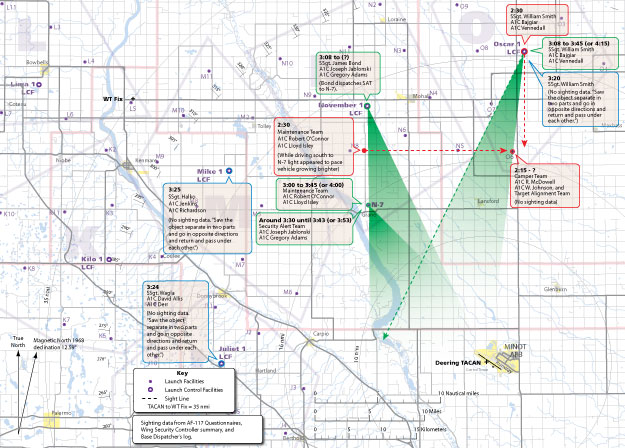
After Jablonski and Adams arrived at N-7 around 3:30,
the personnel continued observing the UFO in the southeast for
approximately 30 minutes. During this time, Smith was also observing the
UFO from O-1, 19 miles to the northeast of N-7. Based on data in the
AF-117s, Smith observed the UFO “off and on” south southwest of his
position for a length of time of one hour and fifteen minutes
[2:30-3:45]; and also reported the time of his last sighting as 4:15,
for a period of one hour and forty-five minutes (1, 3).
O’Connor continued to observe the UFO that went “out of sight” a few
times southeast of N-7 for one and a half hours [2:30-4:00]; and also
reported the time of his last sighting as 3:45, for a period of one hour
and fifteen minutes (1, 3). He estimated the distance of the UFO as
1/2-6 miles (7). Jablonski notes they observed the UFO for 35 minutes
after 3:08 [until 3:43], estimating the distance of the UFO as 3-5 miles
(AF-177,
3, 7). Adams notes they observed the UFO for 45 minutes after 3:08
[until 3:53], estimating the distance of the UFO as 2-5 miles (AF-117,
3, 7). All of the observers at N-7 note the UFO disappeared at the same
time the B-52 appeared in the west. Based on information in the
Transcription, and our reconstruction of the B-52 flight track, this was
until 4:02.[45]
As the observers at N-7 continued reporting the UFO, the base
communications networks were buzzing with activity. O’Connor recalls:
“We conversed back and forth and then everybody, we started hearing all
the chatter on the radio from everybody else that was seeing this
thing.”[46]
Jablonski recalls that after they arrived at N-7:
JABLONSKI: We took over because we were talking to my boss [Bond] and the capsule crew. I mean, there were so many people on that radio that…
INTERVIEWER: Who else?
JABLONSKI: People from the Squadron, people at the base, then when they diverted the B-52, I was talking to the ‘52 people.[47]
The missile Wing Security Control communication network was also patched
in to RAPCON, and the capsule crews were listening in the hope that an
incoming B-52 would provide their eyes in the sky. Smith insisted:
SMITH: I’m the Staff Sergeant and I don’t usually call out of my chain of command unless I’m really frightened. So, I used my chain of command, I called back the people that I deal with, so I’ve done what I’m supposed to do and I just keep it under advisement. I talked to my capsule crew. Depending upon the crew they were interested or not interested. But it got frustrating; we got really angry that nobody was listening to us. So, I remember after I got my crew more interested then they [finally] called. Now the plot thickens because they started calling people and said, “My people upstairs are saying here’s what’s happening and we want some more information.” So they did call the Tower, and matter of fact, I remember listening on the phone—they let me stay on and listen. They called their Operations [Wing Security Control], who said, “OK, let’s get somebody else to think about this.” Then the B-52 crew was called in. They said, “we have a B-52 that’s out and we’ll see what they can see.” That is how we got the [B-52] crew involved. [48]
-----------------------------------------
Narrative of UFO Events at Minot AFB
on 24 October 1968
Thomas Tulien
2. B-52 Air-radar UFO Observation (3:44-4:02)[49]

B-52 Aircraft Commander and pilot, Captain Don Cagle;
Co-pilot, Capt. Bradford Runyon Jr.; Radar Navigator, Major Charles
“Chuck” Richey (dec.); Navigator, Capt. Patrick McCaslin; Electronic
Warfare Officer, Capt. Thomas Goduto; and Gunner, Technical Sergeant
Arlie Judd Jr. All crewmembers were rated as instructors in their
respective positions, establishing them as one of the top crews at Minot
AFB in 1968. During this particular mission, there was an additional
pilot aboard from another B-52 crew, Maj. James Partin, being evaluated
by Cagle. When it became apparent that the crew were being asked to look
for a UFO, Cagle dismissed himself from the flight deck, leaving Partin
and Runyon in charge for the remainder of the flight.
In the midst of the events, a Boeing B-52H Stratofortress long-range
bomber of the 23rd Bombardment Squadron, 5th Bombardment Wing (Heavy) at
Minot AFB, returned from a 10-hour training mission.[50]
The precise time the B-52 returned, and particularly, its whereabouts
for the first hour and a half of the UFO observations are not clearly
established in the Project Blue Book documentation.[51]
Col. Werlich later commented in the Basic Reporting Data:
AT THE TIME OF THESE EVENTS, A B-52 WAS IN THE LOCAL AREA. THE AIRCRAFT INITIALLY ARRIVED IN THE AREA ON A 50 [NAUTICAL] MILE RADIUS CLEARANCE WITH A BLOCK ALTITUDE OF FL210 [Flight Level 21,000 feet] TO FL230 AND BEGAN VARIOUS INSTRUMENT PRACTICE MANEUVERS INCLUDING A VERTICAL “S” PATTERN. THIS TOOK PLACE AT ALMOST THE SAME TIME AS THE FIRST GROUND SIGHTING.[52]
The B-52 Navigator, Captain Patrick McCaslin, recalls that they were
returning about 3:00 in the morning, possibly from Grand Forks AFB, east
of Minot:
McCASLIN: I want to say we’d been over to Grand Forks and shot some approaches there. I don’t think we had done a lot of navigation-type things like low-level routes, or high-level bombing, or any of that stuff. I think it was mostly a pilot’s-type mission. But at some point around—my memory is about 3:00 in the morning—we showed up at Minot, and the reason I think we were coming from Grand Forks, my memory is that we were coming from the east to the west and flew an approach of some kind into the runway, did a low approach as I remember it.[53]
Upon entering the Minot area, defined by a 50-nautical mile
circumference around Minot AFB under the control of Radar Approach
Control (RAPCON), the B-52 pilots practiced routine high-altitude
instrumented procedures. Because of their altitude, and without landing
lights, it is doubtful that anyone on the ground could have possibly
seen them, especially with the extended overcast.[54]
In a February 2005 interview, the B-52’s co-pilot, Captain Bradford Runyon Jr., recalls:
RUNYON: I think we did some high altitude work, probably some vertical S’s, maybe some steep turns you know, maybe some 60-degree bank turns.
INTERVIEWER: That is at 20,000?
RUNYON: Right, at higher altitude, like for the vertical S’s we might have gotten a block from 20 to 30; or 30 to 40,000 feet for that.
INTERVIEWER: That is what?
RUNYON: Just go up and down, certain air speeds, certain rates of descent and then do 60-degree banking turns—that is high altitude. We are probably at 40,000.
INTERVIEWER: So nobody could see you up there.
RUNYON: No, no way, and we were probably not over our base anyway—were out in the middle of nowhere. [55]
Following this, the B-52 departed FL200 and descended from the southeast
for a low approach over the runway at Minot AFB. At 3:34 [3:44],
co-pilot Capt. Runyon requested clearance to fly out to the Tactical Air
Navigation (TACAN) aid, referred to as the TACAN initial approach fix,
or simply “WT fix,” located 35 nautical miles to the northwest near
Bowbells, North Dakota.[56]
Werlich comments:
AFTER A VOR PENETRATION, LOW APPROACH AND MISSED APPROACH TO RUNWAY 29 AT MINOT AFB THE AIRCRAFT CLIMBED TO FL200 ON A HEADING OF 292 DEGREES[57]
The Transcription of Recorded Conversations between Runyon and the
RAPCON ground controller begins at 3:34 [3:44], and establishes a
timeline and relative location of the B-52 over the next hour.[58]
However, the first statement at 3:30 [3:40] notes RAPCON controllers
“received information on UFO 24 miles NW” of the base. The source of the
information is unknown. The location is in Mike-Flight about 7 miles
west-northwest of the observers at N-7, who were reporting another UFO
in the southeast.
Transcript of tape for 24 Oct 68 from 0830 to 0915ct = [radar approach] controller [MIB]
[3:30 to 4:15 a.m. CDT][59]
ac = [B-52] aircraft [JAG 31]
tw = [control] tower
03:30 Controllers received information on UFO 24 miles NW [3:40] 03:34 JAG 31 a B-52 on a TA calibration check to rw [runway] 11 requested clearance to WT at FL200 [3:44] 03:34 ac $MIB approach control does JAG 31 have clearance to WT fix at FL200? [3:44] ct JAG 31 roger climb out on a heading of 290 climb and maintain 5000. Standby for higher altitude. We’re trying to get it from center now. 03:35 ct JAG 31 climb and maintain FL200 [3:45] ac Roger 31 leaving 5000 for 200 ct 31 roger ct And JAG 31 on your way out to the WT fix request you look out toward your one o’clock position for the next 15 or 16 miles and see if you see any orange glows out there. ac Roger roger…glows 31 ct Somebody is seeing flying saucers again. ac Roger I see a …(garbled)[60]
When it became apparent the pilots were being asked to search for a UFO,
Aircraft Commander Capt. Don Cagle excused himself from the flight
deck, and for the remainder of the flight isolated himself in the bunk
area leaving Runyon and Major James Partin—a non-crew pilot being
evaluated by Cagle during this mission—in charge.[61]
Cagle planned to be on a commercial flight to Atlanta later that morning
for a job interview with Delta Airlines. He had missed a similar
appointment one month earlier, due to an unannounced Operational
Readiness Inspection on base. His concern was that any direct
involvement would require him to be present at Minot and miss yet
another opportunity for a new career.[62]
After RAPCON’s request at 3:35 [3:45] for the pilots to look out in the
direction of N-7 for “any orange glows out there,” and a final
“(garbled)” response, there were no further communications with the B-52
for 7 minutes. Ascending to the flight level altitude at 20,000 feet,
the pilots would have had limited ability to see anything as a result of
the extended overcast and haze reported above 10,000 feet.[63]
When communications resumed at 3:52, the B-52 was about 34 nautical
miles northwest of the base, and in the beginning stages of executing a
standard 180-degree right turnaround back over the WT fix. On
completion, the aircraft was aligned on a straight approach to the
runway to begin its descent back to Minot AFB. Once again, RAPCON
alerted the B-52 crew, “0352 [JAG]31 the UFO is being picked up by the
weathers [sic] radar also, should be at your 1:00 [o’clock]
position 3 miles now.” Runyon responded, “We have nothing on our
airborne radar and I am in some pretty thick haze right now and unable
to see out that way.”[64]
McCaslin, downstairs in the belly of
the B-52, aroused Radar Navigator Major Charles (Chuck) Richey, requesting that
he switch the radar to a 360-degree surveillance mode designated “Station
Keep.”[65]
In this mode, the coverage is elevated and concentrated close to the aircraft;
used primarily for formation flying, and lining up behind the docking boom of a
KC-135 air-refueling tanker.[66]
Following this, McCaslin noticed a bright echo appear on his radarscope in the
same location indicated by the weather radar:
McCASLIN: We’re climbing out to do this approach, and we were asked to keep our eyes open for anything strange. No one had said anything like UFO or anything like that. It was just, “Keep your eyes open for anything.” Since I was flight-following the approach anyway, I asked Chuck to put it in Station Keep mode, because I figured if there is anything in the area my best chance to see it would be in Station Keep—more energy, closer. And he did that for me. As we climbed out, I monitored the direction we were heading, the altitude, and I watched the scope. At some point on the way out to the VOR, or to the Nav-aid, I saw a weak—off to our right, maybe 3 miles out—I saw a weak return, one scan. The next scan, there was a very strong return at that location about 3 miles off our right wing, which meant to me that something had either climbed into the radar energy, which was why it would be weak as it entered it, and then was about co-altitude in the next sweep, or it could’ve descended into it. Don’t know which. But it was clear that something was out there and it was large. It was as big or bigger than a KC-135. My impression was it was a larger return than the KC-135 gave me. So I called the pilots and said, “There’s traffic off our right wing at 3:00. Looks like co-altitude,” and nobody saw anything. So I kept watching this thing. The pilot’s basically said, “Keep us advised,” and I think I may have called them a time or two and said “It’s still out there.”[67]
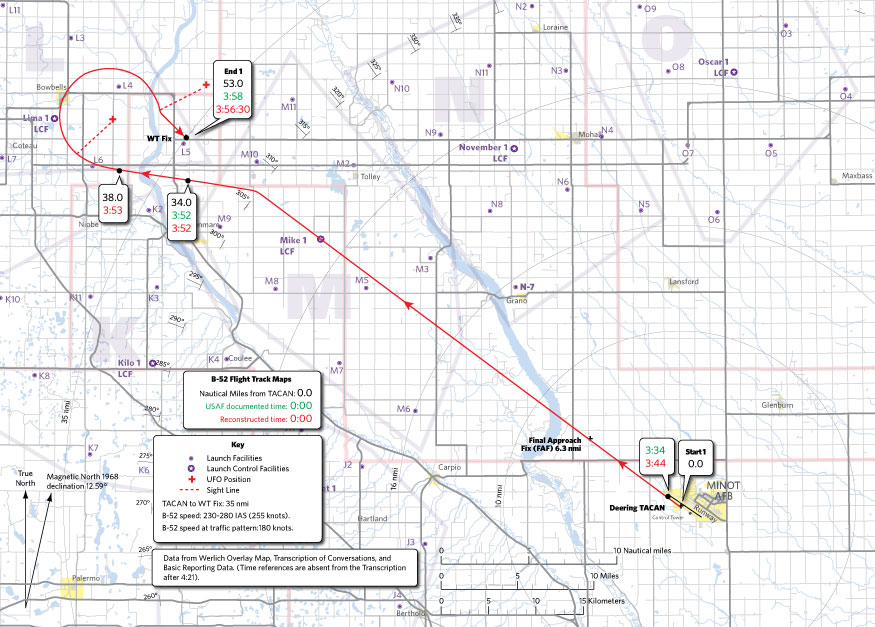
At 3:34 [3:44] the B-52 is over the runway requesting
clearance to the WT fix. At 3:35 [3:45] RAPCON requests that they lookout at
their right for the next 15-16 miles “for any orange glows out there.” At 3:52, RAPCON informs the pilots that
the weather radar located the UFO 3 miles to their right at one o’clock.
McCaslin asked Richey to switch the radar mode to Station Keep, and at about
3:53 observed the UFO 3 miles off the right wing of the B-52. As the B-52
continued the turnaround back over the WT fix, the UFO maintained the 3-mile
distance, transiting to the northeast outside of the B-52 turn radius.
McCaslin also requested that Richey
switch on the 35mm camera mounted over the top of the radarscope. The camera
films the 10-inch radarscope, while superimposing the data plates via a
separate optical path. It automatically exposes one frame during a three-second
time exposure, which is equal to one complete rotation of the radar beam sweep.[68]
Safely turning a B-52 around requires
about a three-mile radius, and the presence a large, unknown aircraft at
co-altitude inside the turn-radius presented a
serious safety concern for the crew. Yet, as the B-52 banked around the wide
turn, McCaslin watched the object on the radarscope moving out to the
northeast, while maintaining the three-mile separation in relation to the
turning aircraft. This allowed the B-52 to safely turn inside, and the object
ultimately assumed a position 3 miles to the left of the B-52 at the completion
of the turnaround:
McCASLIN: I advised the pilots that it was still out there, and as we approached the VOR [WT fix], my memory is that we were going to make a right turn into the VOR . . . and then start our descent over the VOR headed back toward the base. And that was of some concern to me because we were turning into this thing.
INTERVIEWER: It was off your right side?
McCASLIN: Yeah, and I may have—I can’t believe that I would not have advised the pilots, “we’re going to be making a right turn in the direction of this thing,” and it was, “Keep us advised.” So they started their turn back to the VOR, and my clear memory is that as we turned back, this return moved out at the same rate we were turning in—it moved out to the northeast—and by the time we rolled back out headed southeast to start the approach it was 3 miles off our left wing, and I advised the pilots of that.
INTERVIEWER: So it moved relative to you? How many miles?
McCASLIN: I can’t remember the turn rates of a B-52 anymore—but relative to a track over the ground, it must’ve moved 6, 7, 8 miles to the northeast to accommodate the turn we made.
INTERVIEWER: You’re implying intelligence there, aren’t you?
McCASLIN: Yeah, I guess I am.
INTERVIEWER: What did you think at the time this thing was?
McCASLIN: I really didn’t—I don’t know that I thought it was anything. I mean my first concern was that it was an aircraft of some kind. I was worried about hitting an aircraft.[69]

Partial scan of Col. Werlich’s Overlay Map showing the B-52
flight track and 180-degree turnaround back over the WT fix (black circle). The
UFO positions (red X’s) and flight track are in red, while the blue section is
Werlich’s estimate of where the radarscope photographs were exposed. Actually,
the 14 photos appear to show the UFO spiraling around behind the B-52, from a
position front-right of the aircraft to a position 1 nmi off the left wing
before disappearing from the radarscope. Werlich also indicated six lat./long.
coordinates to accurately align the overlay onto a base map ([Werlich Overlay Map).
At 03:56, the B-52 requested routine
approach procedures, acknowledging “wilco” to RAPCON’s request to “report
leaving [FL]200 on this approach.”[70]
Shortly after, the aircraft would pass over the WT fix and depart FL200 to
begin its penetration and descent back to Minot AFB.[71]
At this time, the object’s return on the radarscope remained as bright as it
had been, indicating to McCaslin that the UFO was following at a distance of 3
miles, while also descending at the same rate as the B-52. It was now clear to
the crew that a large unidentified object was keeping pace with them, though
there was little they could do except keep a watchful eye on the situation.
McCASLIN: We’re now in the descent and this thing’s apparently descending with us. I advised the pilots of that. It seemed to me that the pilots were getting a lot more interested in it. There seemed to be a lot of talk on the intercom, ‘Do you see it? I still don’t see it,’ that kind of thing. It’s clear now that whatever this is [was] staying with us, and that’s cause for concern, since—I think there were calls to the tower, although I may not have heard those, I think there were calls about, “Do you have traffic?”—and no one was owning up to any traffic in the area. . . . As we descended on the approach, it stayed as bright as it had been, which for a navigator means, or a radar navigator, it is remaining co-altitude. In other words, it is descending at the same rate we are.[72]
At 3:58, the B-52 abruptly lost two-way
communications with RAPCON, at the same time that the UFO suddenly reduced its
distance from three miles to one. The seemingly instantaneous change of
position occurred in less than a three-second sweep of the radar antenna.
Runyon recalls that the object’s movement occurred so unexpectedly that it
startled Radar Navigator Ritchey, and by the shrill tone of his voice over the
interphone, for a second, Runyon imagined that a collision was imminent.[73]
McCaslin recalls:
McCASLIN: So at some point in the descent, with this thing still shining out there, I saw it at 3 miles on the left, and then the next scan it was at one mile. I mean it was just—there was no sense of it closing. There was no time for that. It was at 3 miles at one point, and the next scan it was one mile off our left wing. I was on the intercom immediately and called the pilots and said, “Hey, this thing’s one mile off our left wing now,” and, well I knew whatever it was, in my own mind, at that point I knew there was something there that I’d never seen on radar. The ability to close 2 miles and stop instantaneously was—although I wasn’t a pilot yet, I went to pilot training 2 months after that and I did a lot of flying, and I don’t know of anything—been a lot of R&D since I got out—but certainly at that time, and during [my] career when I was flying as a pilot I didn’t know of anything that could go laterally in 3 seconds, 2 miles, and just stop.
INTERVIEWER: And maintain your airspeed.
McCASLIN: Right. It was maintaining our descent rate, and then just laterally into one mile—perfect formation. So the pilot’s were telling me they were looking. They still didn’t see anything. No one claimed to see anything at that point. And it was about that time that the tower, and I don’t remember exactly how the loss happened, but the tower either lost our transmission to them, or we lost contact with the tower, but we did not have two-way communications with the tower anymore.
INTERVIEWER: And at what point did you realize that was the case?
McCASLIN: That happened as soon as I called up—right about the time I called up and said, “This thing’s a mile off our left wing.”
INTERVIEWER: When you start to do your descent for approach, that’s when your radios go down?
McCASLIN: No. We started the descent; it stayed 3 miles off our left wing. At some point during the descent it moved in to a mile. And just from one scan to the next—at that point, we lost two-way communications with the tower.[74]
Capt. Runyon, from his position on the
flight-deck, recalls the abrupt change of position of the UFO and loss of radio
transmission occurring at the WT fix, prior to the start of descent. Due to the
sudden loss of radio transmission he was concerned about his inability to
report leaving FL200.
RUNYON: The Navigator told me that we had something off our right wing at 3 o’clock and of course I am looking there too, and I really can’t see it.
INTERVIEWER: At that point you are in what direction in relation to the base?
RUNYON: We’re still flying away from the base and we still haven’t reached our TACAN penetration point. So we’re flying out through there with the object showing on radar, and I don’t know whether it blended in with the night and the clouds, haze, or whatever we had. I don’t know why I couldn’t see it…. And so we reached our penetration point and our radios had quit working when the object got in close to us. I’m not sure just at what point I realized that we couldn’t talk to the ground, but we made our turn and penetration back towards the base and departed our altitude without receiving permission, which bothered me at the time because it was basically illegal to change your altitude without approval beforehand. [75]
Runyon’s
recall is consistent with his later communications in the transcription at
4:04, when the controller asked, “I was wondering how far out did you see that
UFO?” “At 35 miles when we started in,” Runyon replied.“I wonder if that could
have been your radio troubles,” queried the controller. “I don’t know,” Runyon
said, “but that’s exactly when they started.”[76]
After the B-52’s radio transmission
abruptly broke off in mid-sentence, the B-52 could still hear the controller,
but RAPCON could not hear the B-52, and were apparently unaware of the UFO
pacing the aircraft. The controller requested them to “squawk ident,” which
meant to use the aircraft’s SIF/IFF transponder to paint a bright blip on
RAPCON’s radarscope, signaling that the pilots could hear the controller’s
transmission.[77] Satisfied
that the B-52 could hear them, the controller then contacted the Minot AFB
Control Tower to clear the runway for the approaching B-52:
03:58 ac Approach control 31 ct 31 go ahead… 31 go… JAG 31 Minot go ahead… 03:59 ct JAG 31 Minot approach go ahead… JAG 31 if you hear me squawk ident… 31 Minot 04:00 ct JAG 31 if you hear me squawk indent…. JAG 31 ident observed cleared for the approach attempt contact on frequency 271.3 and you’re cleared for the low approach ct to tw Tower this is on JAG 31, disregard, he’s about 24 miles out but can I have clearance on him now for a low approach, he might be having radio problems tw Cleared for low approach wind 15002 ct JAG 31 you’re cleared for low approach wind 15002, if you hear me squawk ident ct JAG 31 if you’re having any other difficulties besides radio transmitter squawk mayday…. (no mayday squawk was received)[78]
The B-52
attempted to communicate with RAPCON on two different UHF radios but neither
would transmit during this time.[79]
However, they were able to signal RAPCON they were in no immediate danger,
which was a grave concern, since three weeks earlier a B-52 experiencing
technical problems on approach had crashed, killing four crewmembers.[80]
The B-52 continued its descent, still
unable to visually observe the pacing UFO through the haze. According to
Werlich, the “RADAR ECHO ACCOMPANIED AIRCRAFT TO APPROXIMATELY 14 NAUTICAL
MILES, 296 RADIAL, APPROXIMATELY 9,000 FEET MSL,” at which point it departed.[81]
As the object left his radarscope, McCaslin’s impression was it descended,
dropping out of the radar energy, so he noted the precise ground coordinates in
the bomb navigation system.[82]
At the same time, the B-52’s radio transmission with RAPCON was suddenly
restored.
04:02 ac Minot approach control JAG 31 how do you hear ct You’re loud and clear how me ac Roger you’re loud and clear ct Remain this frequency ac Our UFO was off to our left there when we started penetration ct Roger understand you did see something on your left side ac We had a radar return at about a mile and a quarter nine o’clock position for about the time we left 200 to about 14 04:03 ct JAG 31 how do you hear this transmitter? ac You’re loud and clear how me ct You’re loud and clear also ac OK. I’ll stay on this frequency? ct Affirmative I was wondering how far out did you see that UFO? ac He was about 1½ miles off our left wing at 35 miles when we started in and he stayed with us ‘til about 10 ct I wonder if that could have been your radio troubles ac I don’t know.… but that’s exactly when they started.[83]
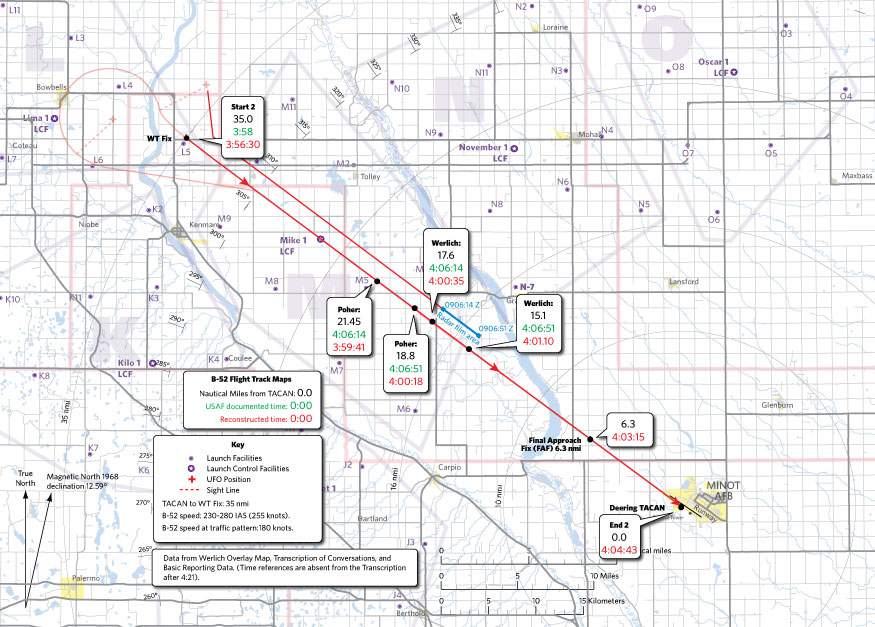
Clearing the WT fix, the UFO rapidly closed distance
to one mile, and the B-52 radio transmission failed. Werlich notes in
the Basic Reporting Data that the “RADAR ECHO ACCOMPANIED THE AIRCRAFT
TO APPROXIMATELY 14 NAUTICAL MILES, 296 RADIAL, APPROXIMATELY 9,000 FEET
MSL” before disappearing from the scope (3). Based on an analysis of
radarscope photo #783, Dr. Claude Poher locates the B-52 at 18.8 nmi at
an altitude of 8865 feet. It is notable that the UFO disappeared from
the radarscope shortly before emerging in to view below the overcast at
9,000 feet. Note: Our reconstructed time during this segment is 1 minute
and 28 seconds behind the documented time, perhaps because the B-52
speed during the turnaround back over the WT fix was less than the
average of 255 knots. The radarscope photo time (4:06:14-4:06:51), which
is also the B-52 onboard time, is ahead by more or less than 6 minutes.
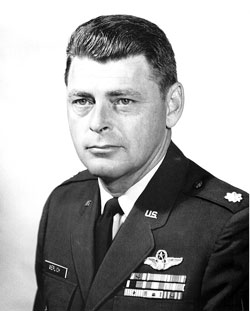
Lt. Col. Arthur Werlich transferred to Minot AFB in July
1968 as chief of Base Operations, and director of the T-29 aircraft ground
school and flight training program. In addition, he was appointed Blue Book project officer responsible for
investigating UFO reports at Minot AFB. This case was his first official UFO
investigation. Col. Werlich retired from the USAF in 1970, and passed away in
March 1992.
Col. Werlich provides two separate
accounts of the B-52 radar encounter in the documentation. The first is a 24
October, Memo for the Record of his telephone conversation reporting the
incident at 4:30 p.m. (CDT) to Project Blue Book chief Lt. Colonel Hector
Quintanilla, Jr., and his assistant 2nd Lieutenant Carmon Marano, in
the Aerial Phenomenon Branch at the Foreign Technology Division (FTD),
Wright-Patterson AFB, Ohio.[84]
Evidently, Werlich had spent most of the day trying to reconstruct the events.[85]
This Memo for the Record provides a calculated speed of the UFO and its initial position to the right of the B-52, though the right-to-left (of the
B-52) movement appears out of sequence. He initially informed Blue Book duty
officer Sgt. Harold Jones “that the crew of a B-52 had sighted and photographed
an [sic] UFO and that the Base Commander and Major
General Nichols of the 15th Air Force were both interested.”[86]
Jones contacted Marano, who returned to the office and informed Quintanilla,
before phoning Werlich back. Marano asked whether he required an immediate
reaction, to which Werlich responded “No,” however, “since it was such an
unusual sighting he [Werlich] wanted to know if we could help him in any way.”
Marano asked for the details:
At about 0300 hours local, a B-52 that was about 39 miles northwest of Minot AFB and was making practice penetrations sighted an unidentified blip on their radar. Initially the target traveled approximately 2½ mile in 3 sec or at about 3,000 mi/hr. After passing from the right to the left of the plane it assumed a position off the left wing of the B-52. The blip stayed off the left wing for approximately 20 miles at which point it broke off. Scope photos were taken. When the target was close to the B-52 neither of the two transmitters in the B-52 would operate properly and when it broke off both returned to normal function.[87]
Col. Werlich’s second account, written
four days later in his comment section of the Basic Reporting Data, provided
some corrections to the original report, and more details, while omitting the
weather radar detection; initial B-52 radar detection to the right-side of the
aircraft; the right-to-left (of the B-52) movement of the UFO; and the speed
calculation.
AFTER ROLLING OUT OF A RIGHT TURNAROUND TO THE TACAN INITIAL APPROACH FIX, A BRIGHT ECHO SUDDENLY APPEARED 3 MILES ABEAM AND TO THE LEFT OF THE AIRCRAFT. THE ECHO RAPIDLY CLOSED ON THE AIRCRAFT AND REMAINED AT ABOUT 1 MILE. AT THIS MOMENT THE UHF TRANSMISSION FROM THE B-52 TO RAPCON WAS INTERRUPTED IN MID-SENTENCE. THE RADAR ECHO CONTINUED WITH THE AIRCRAFT DURING ITS TACAN PENETRATION FOR ABOUT 20 MILES. RAPCON HAD REQUESTED THE AIRCRAFT TO CHANGE UFH FREQUENCIES TWICE BUT THE AIRCRAFT WAS UNABLE TO TRANSMIT ON EITHER FREQUENCY. THE B-52 UHF RECEIVER WAS NOT AFFECTED NOR WAS THE IFF/SIF IDENTIFICATION FEATURE AFFECTED. DURING THIS TIME, RADAR SCOPE PHOTOS WERE OBTAINED AND CLEARLY SHOW THE RADAR ECHO. AS SOON AS THE ECHO DISAPPEARED THE B-52 UHF TRANSMITTER BECAME OPERATIONAL. WHATEVER CAUSED THE ECHO WAS NOT VISUALLY SIGHTED BY THE AIRCRAFT CREW MEMBERS NOR WAS IT SEEN BY THE TOWER OPERATOR WHO WAS FOLLOWING THE AIRCRAFT PROGRESS THROUGH BINOCULARS. DUE TO HEAVY HAZE AND SEVERAL CLOUD LAYERS, THE AIRCRAFT WAS NOT VISIBLE THROUGHOUT THE APPROACH. [88]
During the B-52 radar encounter, the
missile Wing Security Control communication network was patched-in to RAPCON,
and the underground capsule crews were closely following the progress of the
B-52. The Oscar-capsule crew allowed Flight Security Controller SSgt. Smith to
listen-in to the comunications between the B-52 and RAPCON, though the radio
transmission was patchy and difficult to hear:
SMITH: Matter of fact, we had an officer I think on the phone with the capsule crew, and of course I was patched in, they were asking me questions, and they said, “Well OK, we’ll have a diversion of this B-52 crew coming in,” and they gave a time when it would be coming. . . . They described it, said, “We’re breaking off” and then it followed them back for a certain time, and my understanding was that they lost them on radar, and we were able to hear that, they said, “We don’t have them on radar right now.” And so the conversation was, “My gosh what may have happened?” Then when it got within so many miles of the base they were able to pick them up on radar again, and the traffic came. Matter of fact, I remember they kept calling them trying to get them on radio and there was no radio transmission either and everybody was concerned at that time because they hoped they didn’t crash.[89]
FSC SSgt. Bond
recalls the November-capsule crew informing him of the B-52 encounter:
BOND: The combat crew did tell me that there was a B-52 being rerouted to the area and they were going to check on it. They also told me that they had been talking to the B-52 crew by radio from the capsule and about seeing the thing, it following them, also about losing all communications in their airplane when it got close to them, and for how many minutes they had no contact with the support base or anything else. Yeah, that was real strange. . . . Not much more than that they were pretty tight lipped about it. They wanted to know what I was seeing.[90]
------------------------------------------


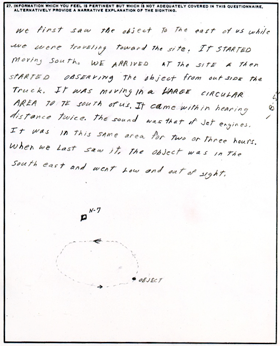


No comments:
Post a Comment